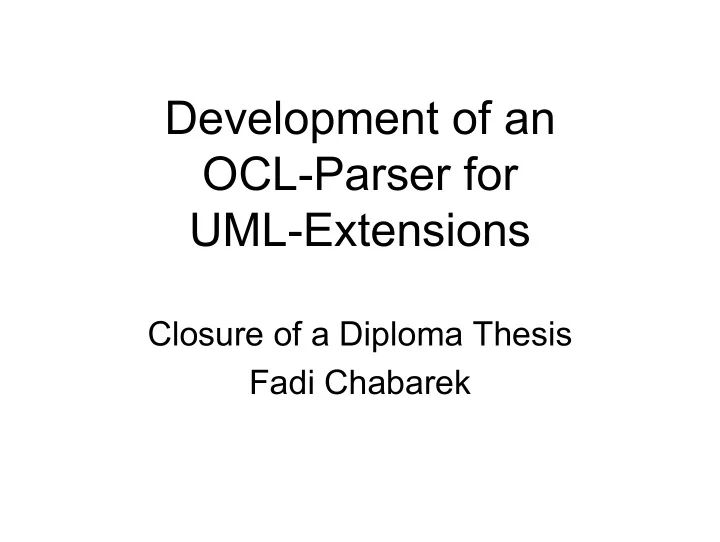

Development of an OCL-Parser for UML-Extensions Closure of a Diploma Thesis Fadi Chabarek
Introduction • Short explanation of the subject and its main technologies • Introduction to the developed solution: – framework‘s architecture – model interface – parser, context checker, interpreter – MOF Bridge
OCL • Semiformal Constraint Language • Part of the UML • Supports invariants, pre and post conditions • Constraints are defined for types / model elements: context Company inv: self.numberOfEmployees > 50 context Person::income(d : Util::Date) : Integer post: result = 5000
Metamodeling MOF Model M3 layer: meta-metamodel UML IDL ... Metamodel Metamodel M2 layer: metamodels ... IDL Interface UML Models M1 layer: models M0 layer
Connection: UML Profiles • Extension system of UML • Define additional constraints to the UML Metamodel • Narrow models down to domain specific requirements • Constraints described through OCL can be validated
Diploma Subject • OCL expressions have to be interpreted in the context of UML Profiles and the UML- Metamodels 1.3 and 1.4. • Therefore a „Parser“ has to be developed, which: – gets an UML model instance and an UML-Profile as input – and validates the adherence of the model to OCL constraints defined by the given UML-Profile
Architecture XMI MOF Repository Model Abstraction Layer Parser Context Checker Interpreter OCL Report File Validator
Model Interface • Abstraction Layer to interpret OCL constraints in context of arbitrary models • Designated to be implemented for MOF compliant metamodels • Enables support of different versions of the UML Metamodel
The Interface‘s Basic Idea • OCL is defined in the context of UML • OCL augments its type UML UML-Model arbitrary system through model metamodel Binding model types via UML concepts OCL-UML transitive (e.g. UML Classifier, Binding binding Properties etc.). OCL context • Description of these concepts in a model define the model‘s OCL semantics
Structure of the Model Interface Facade describes the model on its: – Type level: • Packages • Classifiers • Properties – Instance level: • Instances • Reflective Properties for OCL meta level Operations
Parser • OCL Grammar does not produce a LR-Language • Changes to the grammar are necessary • Choice of parser generator: SableCC • Enlargement of the language is circumvent by concrete syntax • New grammar is LALR(1), the parser accepts the same language
Context Checker • OCL type system consists of predefined and model types • Java Interfaces describe predefined types. – Instances implement these interfaces – Java Reflection API resolve the interface‘s properties. – This allows later changes to the OCL type system to be reflected • Model types and their properties are resolved through the model interface
Visitor Pattern • SableCC generates Parser and Visitors. • When a Visitor visits a in out node in three phases: – in … is called when case entering a node 1. 2. 3. ... – case … lets the visitor visit the node‘s children – out … is called when leaving a node
Type check • Implementation of a static type check • Usage of the Visitor-Pattern • AST is traversed bottom-up from left to right by overriding out methods. • Exceptions of this order are implemented by redefining case methods. • Types are determined at the bottom of the tree and used in the parent nodes until the root is reached
Interpreter • Corresponding to the type system there are predefined and model instances • Predefined instances are implemented on the basis of the type interfaces • Model instances delegate to the model interface
Evaluation • Values are evaluated bottom-up from left to right. • Constraints must be evaluated for every instance of a type • The respective constraint holds if the root node evaluated to true
MOF Bridge • Java Metadata Interface (JMI) – MOF Mapping for Java – MDR implementation supports import of metamodel over XMI • JMI enables access to MOF compliant metamodels • MOF Bridge connects the model interface with JMI
Sequence mofFacade mofMetadata validator (MOF Bridge) (JMI) request( OCL/UML concept ) request( MOF concept ) response( MOF concept ) response( OCL/UML concept )
What did we actually achieve? • Concrete JMI technologies (e.g. MDR) represent the UML Metamodels 1.3 and 1.4 and its instances • This representation is translated by the Abstraction Layer of the framework: – MOF to UML by the MOF Bridge – UML to OCL by the model interface and the framework • OCL semantics are stipulated for the UML Metamodels. • Constraints can now be validated by the framework
By-Products The Abstraction Layer of the framework facilitates: • Support of OCL for arbitrary models • Support of OCL for MOF compliant metamodels • The definition of a general OCL tool interface
Conclusion: Summary 1 • Presentation of UML Profiles and the subject of the diploma thesis • Model interface – Basic Idea – Type and instance level • Parser – Changes to the grammar, LALR(1)
Conclusion: Summary 2 • Context Checker – Implementation of the type level – Description of the static type check algorithm • Interpreter – Implementation of the instance level – Description of the evaluation algorithm • MOF Bridge – JMI
Recommend
More recommend